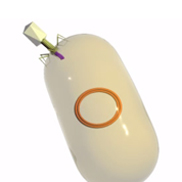« Prev Next »

Some Organisms Transmit Genetic Material to Offspring without Cell Division

Prokaryotes, which include bacteria and single-celled microorganisms called Archaea, usually pass their chromosomal DNA on to their offspring asexually. In other words, a bacterial cell reproduces by simply replicating its chromosome and dividing into two daughter cells. The daughter cells that result from this division are genetically identical to each other and to the original parent cell. Thus, over time, asexual reproduction in bacteria can lead to a population of hundreds of thousands of cells, all of which are genetically identical to a lone original parent cell.
Given their asexual method of reproduction, it is tempting to think that bacteria are sorely lacking in genetic variation, but this is not the case. Prokaryotic cells have developed a number of methods for recombining their genetic material, which, in turn, contributes to their genetic diversity. The three most common ways that bacteria diversify their DNA are transformation, conjugation, and transduction. However, not all types of bacterial cells are capable of engaging in all three processes.
Transformation
Transformation is a process by which a susceptible or "competent" bacterial cell acquires new genetic material from its environment. There are two types of transformation: natural and artificial. But where does the environmental DNA required for transformation come from? And how does this DNA become part of a bacterium's genome?
Natural transformation, as its name implies, is a natural mechanism used by some bacterial cells to take up DNA from the environment. This environmental DNA was, at one point, located in other bacteria. For instance, when bacteria die and disintegrate, their chromosomal DNA is released. Fragments of this DNA remain in the environment and are freely available to other living cells, including other bacteria. These naturally occurring DNA fragments can enter a living bacterium through its cell membrane, after contact with that membrane. If the DNA is double stranded, one of the strands will pass across the cell membrane into the cell, and the other strand will be dissolved, or hydrolyzed. Parts of the newly introduced single-stranded DNA molecule may then recombine with similar regions on the bacterial chromosome and become incorporated into the bacterium's genome.
In contrast, during artificial transformation, DNA uptake by bacterial host cells occurs under certain laboratory conditions. In the lab, scientists often introduce foreign DNA into bacterial cells via transformation in order to study specific genes and their functions. Typically, these researchers use E. coli cells that have been chemically treated so that their outer cell membranes are permeable to foreign DNA. In addition, transformation can be induced by electroporation, a process in which the bacterial host cells are subjected to an electric field that allows molecules to pass more easily across the membrane. Heat shock is another way that transformation can occur, wherein host cells are exposed to extreme temperatures that also cause the cell membrane to temporarily allow molecules of foreign DNA into the cell.
Within the lab environment, bacteria are also commonly transformed with sequences of DNA called plasmid vectors. These naturally occurring DNA molecules are circular, and they can replicate inside a bacterium independent of the bacterial chromosome (which can also be circular). Plasmid vectors can be used to clone, transfer, and manipulate genes. Often, these plasmids carry a gene for antibiotic resistance, which means that researchers can select for cells that are resistant to a given antibiotic in order to determine whether a bacterium has been successfully transformed.
The following animation depicts the process of transformation:
Conjugation
Conjugation is a process by which one bacterium transfers genetic material to another bacterium through direct contact. During conjugation, one of the bacterial cells serves as the donor of the genetic material, and the other serves as the recipient. The donor bacterium carries a DNA sequence called the fertility factor, or F-factor, on a circular, double-stranded plasmid. The F-factor allows the donor to produce a thin, tubelike protuberance called a pilus. The donor uses the pilus to contact the recipient. The pilus then shortens and draws the two bacteria together, at which time the donor bacterium transfers genetic material to the recipient bacterium. This genetic material is in the form of a plasmid, or a small, circular piece of non-chromosomal DNA. The newly transferred genetic material often provides the recipient bacterium with some sort of genetic advantage. In many cases, conjugation results in the transfer of a plasmid containing an antibiotic resistance gene.
Transduction
Finally, transduction is a process by which a virus transfers genetic material from one bacterium to another bacterium. This process depends on a specific type of virus called a bacteriophage, which is capable of infecting bacterial cells and using them as hosts to produce more viruses.
As the first step, a bacteriophage injects its DNA
into a host bacterium. The bacteriophage DNA then takes over the host cell's machinery
and directs it to synthesize and assemble more bacteriophages. During this process, the
host cell's DNA breaks into fragments; after that, the host cell replicates the
bacteriophage DNA and assembles new bacteriophages. Occasionally, some of the bacterial host
cell's DNA is packaged in new bacteriophages during assembly. Once bacteriophage assembly
is complete, the bacterial cell breaks open, and the newly assembled bacteriophages are
released into the environment. Transduction occurs when a bacteriophage containing bacterial DNA infects a recipient bacterium and transfers this bacterial DNA to the recipient bacterial host cell. This transferred bacterial DNA may then be incorporated into the genome of the recipient bacterium.
Further Exploration
Key Questions





















